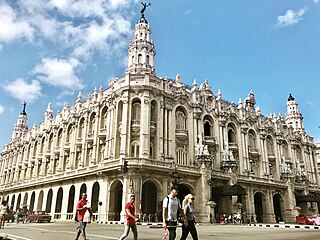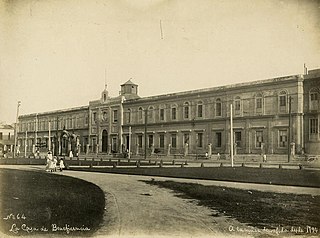
Havana is the capital and largest city of Cuba. The heart of the La Habana Province, Havana is the country's main port and commercial center. The city has a population of 2.3 million inhabitants, and it spans a total of 728.26 km2 (281.18 sq mi)for the Capital City side and 8,475.57 km² for the Metropolitan zone – making it the largest city by area, the most populous city, and the Second largest metropolitan area in the Caribbean region.

The Royal Bank Tower is a skyscraper at 360 Saint-Jacques Street in Montreal, Quebec. The 22-storey 121 m (397 ft) neo-classical tower was designed by the firm of York and Sawyer with the bank's chief architect Sumner Godfrey Davenport of Montreal. Upon completion in 1928, it was the tallest building in the entire British Empire, the tallest structure in all of Canada and the first building in the city that was taller than Montréal's Notre-Dame Basilica built nearly a century before.

Hotel Tryp Habana Libre is one of the larger hotels in Cuba, situated in Vedado, Havana. The hotel has 572 rooms in a 25-floor tower at Calle 23 and Calle L. Opened in 1958 as the Habana Hilton, the hotel famously served as the residence of Fidel Castro and other revolutionaries throughout 1959, after their capture of Havana.

El Capitolio, or the National Capitol Building, is a public edifice in Havana, the capital of Cuba. The building was commissioned by Cuban president Gerardo Machado and built from 1926 to 1929 under the direction of Eugenio Rayneri Piedra. It is located on the Paseo del Prado, Dragones, Industria, and San José streets in the exact center of Havana.

Gran Teatro de La Habana is a theater in Havana, Cuba, home to the Cuban National Ballet. It was designed by the Belgian architect Paul Belau and built by Purdy and Henderson, Engineers in 1914 at the site of the former Teatro Tacón. Its construction was paid for by the Galician immigrants of Havana to serve as a community-social center. Located in the Paseo del Prado, its facilities include theatres, a concert hall, conference rooms, a video screening room, as well as an art gallery, a choral center and several rehearsal halls for dance companies. It hosts the International Ballet Festival of Havana every two years since 1960.

The Gran Hotel Manzana Kempinski La Habana is a luxury hotel in Havana, Cuba. It is located in the historic Manzana de Gómez building, an early-20th-century building that was Cuba's first shopping mall. The Kempinski Hotel chain, belongs to the oldest hotel groups in Europe, Kempinski Aktiengesellschaft.

The Hotel Habana Riviera by Iberostar, originally known as the Havana Riviera, is a historic resort hotel located on the Malecón waterfront boulevard in the Vedado district of Havana, Cuba. The hotel,which is managed by the Spanish Iberostar chain, was built in 1957 and still maintains its original 1950s style. It has twenty-one floors containing 352 rooms all of which feature views of the water and the Vedado neighborhood.

The Hotel Ambos Mundos is a hotel in Havana, Cuba. Built with a square form with five floors, it has an eclectic set of characteristics of 20th-century style architecture. It was built in 1924 on a site that previously had been occupied by an old family house on the corner of Calle Obispo and Mercaderes in Old Havana. It is a frequent tourist destination because it was home to the popular writer Ernest Hemingway for seven years in the 1930s.

The Lonja del Comercio building in Old Havana, Cuba served as the stock exchange in the capital until the 1959 Cuban Revolution. Today, it is an office building.

The Bacardi Building is an Art Deco Havana landmark designed by the architects Esteban Rodríguez-Castells and Rafael Fernández Ruenes and completed in 1930. It is located on the corner of Calles Monserrate and San Juan de Dios on a 1,320 m2 (14,200 sq ft) lot in Las Murallas, Old Havana.

Paseo del Prado is a street and promenade in Havana, Cuba, near the location of the old city wall, and the division between Centro Habana and Old Havana. Technically, the Paseo del Prado includes the entire length of Paseo Martí approximately from the Malecon to Calle Máximo Gómez, the Fuente de la India fountain. The promenade has had several names; it was renamed Paseo de Martí in 1898 with the island's independence from Spain. Despite the historic references, the people of Havana simply call it "El Prado".

Bank of Nova Scotia Building, Havana is a Neoclassical-style bank building located at the intersection of Calle O´Reilly and Calle Cuba in old Havana.
Sumner Godfrey Davenport was an American-born Canadian architect who served as Chief Architect for the Royal Bank of Canada.

Royal Bank Tower (Vancouver) is a 16-storey office tower located in downtown Vancouver and served as the regional office for the Royal Bank of Canada until 1973.

La Casa de Beneficencia y Maternidad de La Habana, was for 270 years Havana's repository of Havana's unwanted children. The House of Charity started during a time when Cuba was experiencing extreme poverty, unemployment, and corruption in the government. Corrupt leaders were plundering the public treasury and little attention was given to social assistance, health, education, or the protection of the poor: "los desamparados".

The Iglesia del Espíritu Santo is a colonial church at #702 Calle Cuba in Old Havana, Havana, Cuba, was built in 1635 on the corner of the corner of Calles Cuba and Acosta. The Espíritu Santo contains some notable paintings including a seated, post-crucifixion Christ on the right wall, and catacombs. It is considered one of the oldest temples in Havana. Free blacks, already numerous, devoted the church to the Holy Spirit in 1638.

The Radiocentro CMQ Building complex is a former radio and television production facility and office building at the intersection of Calle L and La Rampa in El Vedado, Cuba. It was modeled after Raymond Hood's 1933 Rockefeller Center in New York City. With 1,650 seats, the theater first opened on December 23, 1947, under the name Teatro Warner Radiocentro, it was owned by brothers Goar and Abel Mestre. Today the building serves as the headquarters of the Cuban Institute of Radio and Television (ICRT).

Hospital de San Lázaro was a hospital in the city of Havana, Cuba. It dates back to the 17th century, when it served as headquarters for some huts built near the Caleta de Juan Guillén, then known as Caleta de San Lázaro, in an area about a mile outside the city walls.

The Iglesia de San Francisco de Paula, Havana is part of the ecclesiastical heritage of Havana. It is located at 110 Calle Leonor Pérez on the corner of Calle San Ignacio. It is near the bay on the south side of Havana Vieja."

The Colegio de Belén located between 45th and 66th streets, situated next door to the Tropicana nightclub, in Marianao, Havana, was designed in 1925 by the architect Leonardo Morales y Pedroso and his brother the engineer Luis Morales y Pedroso of the firm Morales y Compañía Arquitectos.




























